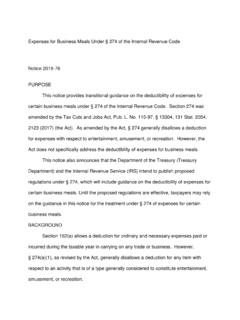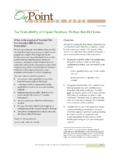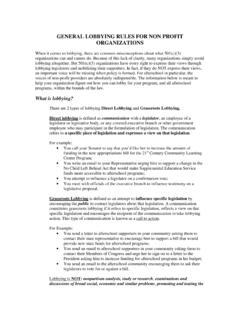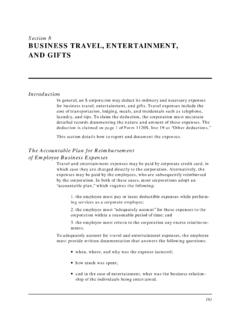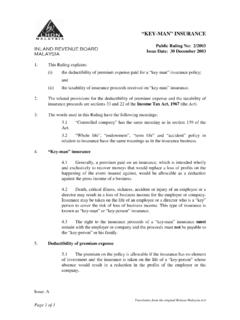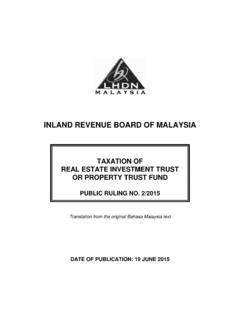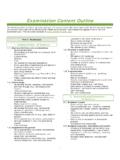Transcription of April 2014 EXEMPT ORGANIZATIONS BUSINESS MASTER …
1 April 2014 EXEMPT ORGANIZATIONS BUSINESS MASTER FILE EXTRACT (EO BMF) INTRODUCTION EXEMPT organization information is extracted monthly from the internal revenue Service s BUSINESS MASTER File. This is a cumulative file, and the data are the most recent information the IRS has for these ORGANIZATIONS . If you have any questions about the tax- EXEMPT ORGANIZATIONS or the content of the files, please contact TE/GE Customer Account services toll-free line at 1-877-829-5500 The files are available in comma separated value (CSV) format and contain the fields described below. They are divided by region and by state. State and region are determined from the filing address and generally represent the location of an organization s headquarters, which may or may not represent the state(s) in which an organization has operations. Records are sorted by Employer Identification Number (EIN). There is one file for each state, the District of Columbia, and Puerto Rico, and one file for International (non-domestic) ORGANIZATIONS .
2 There are four region files: Region 1: Northeast Area - Includes Maine, New Hampshire, Vermont, Massachusetts, Rhode Island, Connecticut, New York, New Jersey Region 2: Mid-Atlantic and Great Lakes Area - Includes Pennsylvania, Ohio, West Virginia, District of Columbia, Maryland, Delaware, Virginia, North Carolina, South Carolina, Michigan, Kentucky, Indiana, Illinois, Wisconsin, Minnesota, Iowa, Nebraska, South Dakota, North Dakota. Region 3: Gulf Coast and Pacific Coast Area - Includes Tennessee, Georgia, Florida, Alabama, Mississippi, Missouri, Arkansas, Louisiana, Texas, Oklahoma, Kansas, Montana, Wyoming, Colorado, New Mexico, Arizona, Utah, Nevada, Idaho, California, Oregon, Washington, Alaska, Hawaii Region 4: All Other Areas Includes International and all others. The IRS EXEMPT organization data have been accumulated since the inception of the tax- EXEMPT statutes. A determination letter is issued to an organization upon the granting of an exemption and is considered valid throughout the life of the organization , as long as the organization complies with the provisions of its exemption.
3 If an organization 's exemption is revoked, an announcement to inform potential donors of the revocation is published in the internal revenue Bulletin. In addition, the organization s name is removed from publicly accessible venues, including this file. A list of recent revocations may be found on the on-line at: (c)(3)-Determinations-Latest-Additions-a nd-Table-of-Links NOTE: Split-interest trusts are no longer included in this database. FIELDS AVAILABLE All EXEMPT organization records on this file will contain the following data fields: Column Name Contents EIN Employer Identification Number (EIN) NAME Primary Name of organization ICO In Care of Name STREET Street Address CITY City STATE State ZIP Zip Code GROUP Group Exemption Number SUBSECTION Subsection Code AFFILIATION Affiliation Code CLASSIFICATION Classification Code(s)
4 RULING Ruling Date DEDUCTIBILITY Deductibility Code FOUNDATION Foundation Code ACTIVITY Activity Codes organization organization Code STATUS EXEMPT organization Status Code TAX_PERIOD Tax Period ASSET_CD Asset Code INCOME_CD Income Code FILING_REQ_CD Filing Requirement Code PF_FILING_REQ_CD PF Filing Requirement Code ACCT_PD Accounting Period ASSET_AMT Asset Amount INCOME_AMT Income Amount (includes negative sign if amount is negative) REVENUE_AMT Form 990 revenue Amount (includes negative sign if amount is negative) NTEE_CD National Taxonomy of EXEMPT Entities (NTEE) Code SORT_NAME Sort Name (Secondary Name Line) DEFINITIONS EMPLOYER IDENTIFICATION NUMBER (EIN) Employer Identification Number (EIN) is a nine digit number assigned by the IRS to identify a particular organization s account.
5 IN CARE OF NAME In Care Of Name is the person (officer, director, etc.) to whose attention any correspondence should be directed. GROUP EXEMPTION NUMBER (GEN) This is a four-digit internal number assigned to central/parent ORGANIZATIONS holding group exemption letters. AFFILIATION CODE Affiliation Code defines the organizational grouping. Code Description 1 Central - This code is used if the organization is a central type organization (no group exemption) of a National, Regional or Geographic grouping of ORGANIZATIONS . 2 Intermediate - This code is used if the organization is an intermediate organization (no group exemption) of a National, Regional or Geographic grouping of ORGANIZATIONS (such as a state headquarters of a national organization ). 3 Independent - This code is used if the organization is an independent organization or an independent auxiliary ( , not affiliated with a National, Regional, or Geographic grouping of ORGANIZATIONS ).
6 6 Central - This code is used if the organization is a parent (group ruling) and is not a church or 501(c)(1) organization . 7 Intermediate - This code is used if the organization is a group exemption intermediate organization of a National, Regional or Geographic grouping of ORGANIZATIONS . 8 Central - This code is used if the organization is a parent (group ruling) and is a church or 501(c)(1) organization . 9 Subordinate - This code is used if the organization is a subordinate in a group ruling. SUBSECTION CODE AND CLASSIFICATION CODE Subsection Codes are the codes shown under section 501(c) of the internal revenue Code of 1986, which define the category under which an organization may be EXEMPT . A table of subsection and classification codes (which reflects a further breakdown of the internal revenue Code subsections) can be found in the section entitled "Table of EO Subsection and Classification Codes" (below). One to four different classification codes may be present.
7 RULING DATE This is the month and year (YYYYMM) on a ruling or determination letter recognizing the organization 's EXEMPT status. DEDUCTIBILITY CODE Deductibility Code signifies whether contributions made to an organization are deductible. Code Description 1 Contributions are deductible. 2 Contributions are not deductible. 4 Contributions are deductible by treaty (foreign ORGANIZATIONS ). FOUNDATION CODE Code Description 00 All ORGANIZATIONS except 501(c)(3) 02 Private operating foundation EXEMPT from paying excise taxes on investment income 03 Private operating foundation (other) 04 Private non-operating foundation 09 Suspense 10 Church 170(b)(1)(A)(i) 11 School 170(b)(1)(A)(ii) 12 Hospital or medical research organization 170(b)(1)(A)(iii) 13 organization which operates for benefit of college or university and is owned or operated by a governmental unit 170(b)(1)(A)(iv) 14 Governmental unit 170(b)(1)(A)(v) 15 organization which receives a substantial part of its support from a governmental unit or the general public 170(b)(1)(A)(vi)
8 16 organization that normally receives no more than one-third of its support from gross investment income and unrelated BUSINESS income and at the same time more than one-third of its support from contributions, fees, and gross receipts related to EXEMPT purposes. 509(a)(2) 17 ORGANIZATIONS operated solely for the benefit of and in conjunction with ORGANIZATIONS described in 10 through 16 above. 509(a)(3) 18 organization organized and operated to test for public safety 509(a)(4) 21 509(a)(3) Type I 22 509(a)(3) Type II 23 509(a)(3) Type III functionally integrated 24 509(a)(3) Type III not functionally integrated TYPE OF organization CODE This defines the type of organization as follows: Code Description 1 Corporation 2 Trust 3 Co-operative 4 Partnership 5 Association ADVANCE RULING EXPIRATION DATE Elimination of the Advance Ruling Process On September 9, 2008, the IRS issued temporary Income Tax Regulations, which eliminate the advance ruling process for a section 501(c)(3) organization .
9 Under the new regulations, a new 501(c)(3) organization will be classified as a publicly supported charity, and not a private foundation, if it can show that it reasonably can be expected to be publicly supported when it applies for tax- EXEMPT status. Under the old regulations, an organization that wanted to be recognized by the IRS as a publicly supported charity instead of a private foundation had to go through an extended two-step process. First, the organization had to declare that it expected to be publicly supported on an on-going basis. Then, after five years, it had to file Form 8734, Support Schedule for Advance Ruling Period, showing the IRS that it actually met the public support test. If it didn't meet the test, it was designated a tax- EXEMPT private foundation and would be subject to stricter rules. The new rules no longer require the organization to file Form 8734 after completing its first five tax years. Moreover, the organization retains its public charity status for its first five years regardless of the public support actually received during that time.
10 Instead, beginning with the organization 's sixth taxable year, it must establish that it meets the public support test by showing that it is publicly supported on its Schedule A to Form 990, Return of organization EXEMPT From Income Tax. Transition rules apply to ORGANIZATIONS that have previously received advance rulings. EXEMPT organization STATUS CODE The EO Status Code defines the type of exemption held by the organization . The following is a list of EO status codes and their definitions included in these files: Code Description 01 Unconditional Exemption 02 Conditional Exemption 12 Trust described in section 4947(a)(2) of the IR Code 25 organization terminating its private foundation status under section 507(b)(1)(B) of the Code TAX PERIOD This is the tax period of the latest return filed (YYYYMM).










